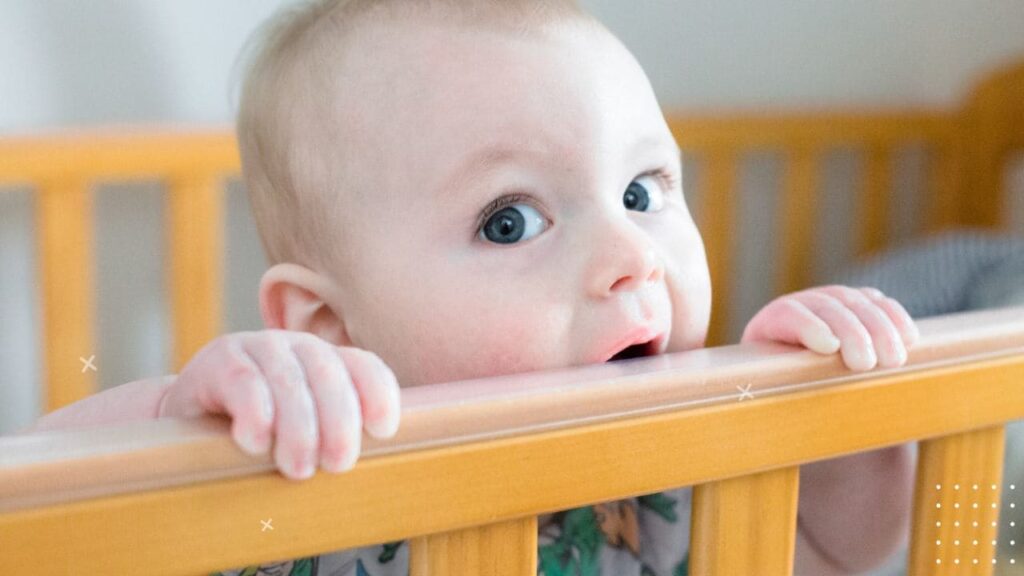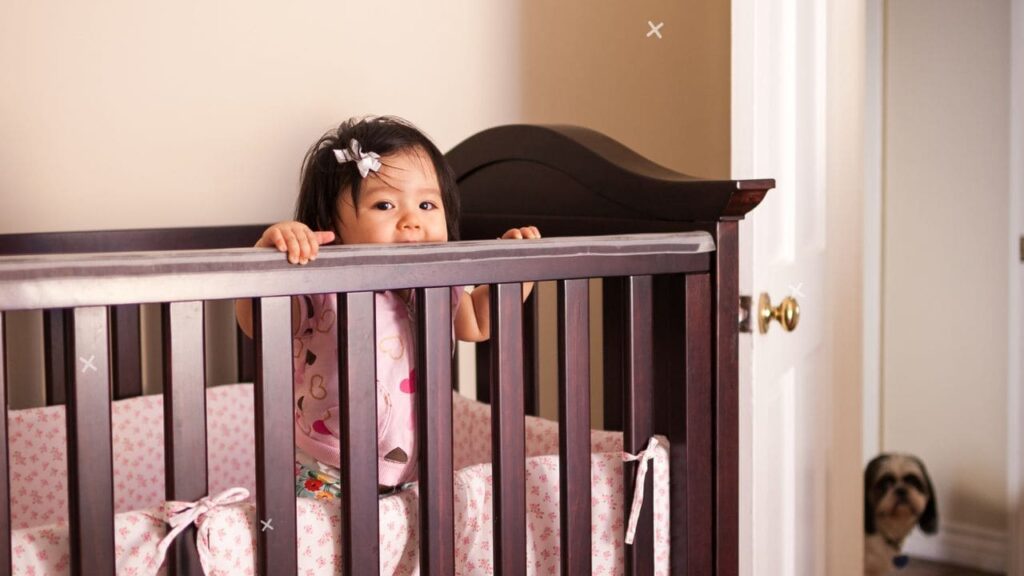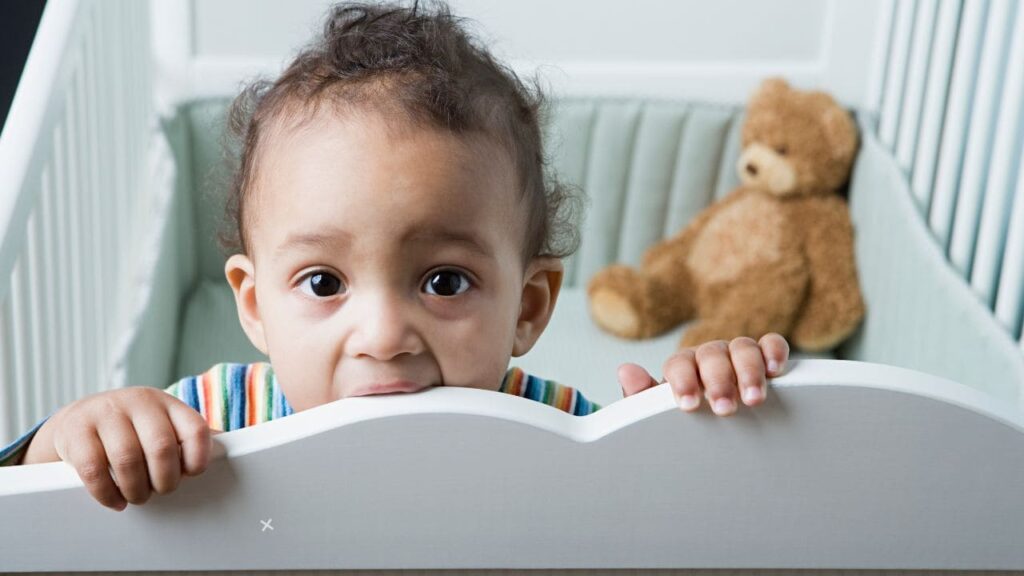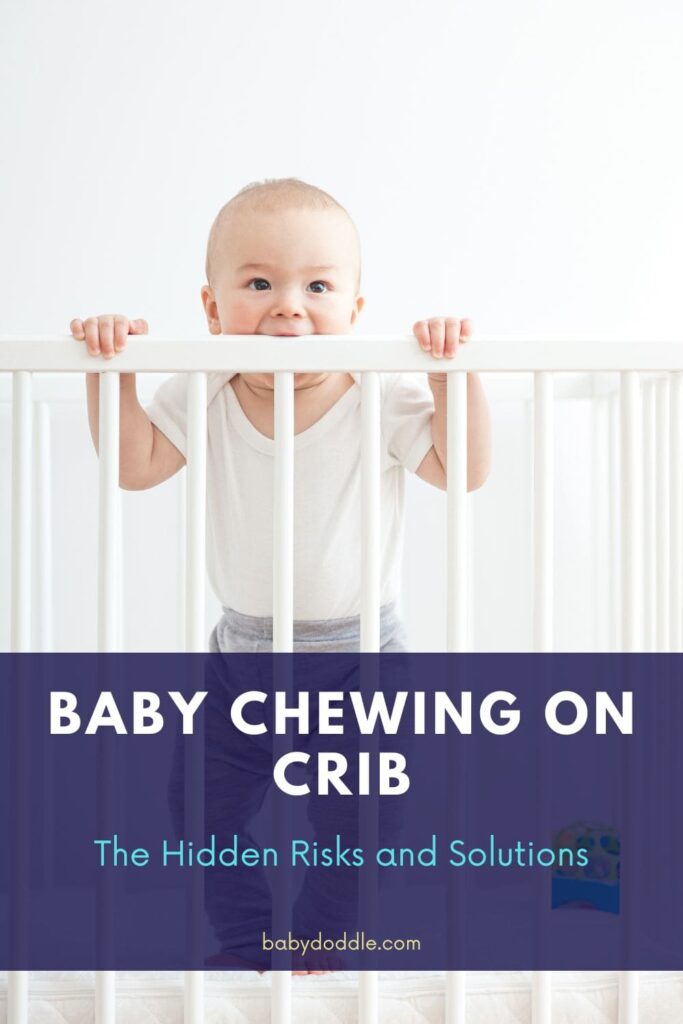As a parent, few things make your heart drop faster than walking into the nursery and discovering teeth marks all over the crib rails from baby chewing on crib parts. I certainly panicked the first time I saw evidence that my daughter had started baby chewing on crib slats and railings! It’s a common reaction many caregivers have upon noticing signs of this phenomenon. But try not to freak out too much. Baby chewing on crib bars or panels is actually pretty normal infant behavior as they explore and seek sensory relief.
Those emerging teeth feel good on the gums. And lets face it, being confined to a crib with minimal entertainment options gives babies ample opportunity to gnaw their boredom away through baby chewing on crib rails. As alarming as the bite marks look initially, rest assured this habit usually phases out on its own without much harm. However, it’s still smart to curb risks from baby chewing on crib parts proactively just to stay on the safe side.
In this post, we’ll break down everything caregivers should know about this phenomenon, from the hidden dangers of baby chewing on crib bars and slats to tips minimizing the chance of damage or injury. Read on for the full rundown!
Why Do Babies Start Chewing Their Cribs?
For starters, don’t take it as a sign your little cherub is turning into a vicious chew monster! There are perfectly normal reasons infants develop this tendency:
Teething Relief
Erupting molars hurt like crazy. The pressure of sore gums makes babies desperately gnaw anything they can latch their mouths on to, bringing much-needed relief through counter pressure. Unfortunately, those brand new pearly whites often lead them to start gnawing their trusty cribs.
Exploring Their Environment
Babies begin understanding their surroundings primarily through touch and taste. Chewing familiar objects like crib railings allows them to literally get a feel for their environment during this crucial sensory development phase.
Boredom
There’s no denying infants spend an awful lot of time confined in cribs with minimal stimulation. Chewing gives them something interactive to pass time when awake and restless.
Early Oral Fixation
Mouthing or chewing behaviors from as early as 2 months old is linked to oral developmental stages in some babies. It’s a harmless phase helping them coordinate gestures, sensory experiences and motor skills through mouth movement.
Of course there some exceptions where chronic crib chewing may indicate other issues like:
- Anxiety/stress
- Attention-seeking behavior
- Sensory processing disorder
But generally, occasional chewing is not at all abnormal for typical healthy babies. Phew!
That brings us to our next question…

What Exactly Are the Risks of Letting an Infant Chew Their Crib?
Just because crib chewing doesn’t seem outwardly alarming at first glance doesn’t mean it poses zero hazards. The biting habit actually hides several critical safety issues parents should stay alert about:
Choking and Poisoning Hazards
Ever noticed those nasty paint chips on window sills and door frames in older buildings? That’s lead paint – a toxic heavy metal banned decades ago for its hazardous health effects, especially on young kids. Cribs made before 1978 may also contain traces of lead-based paint beneath layers of newer coats.
As babies gnaw away, their sharp little teeth can slowly chip deteriorating paint off into tiny flakes getting easily swallowed or inhaled. And it only takes a minute amount of lead entering such tiny bodies to cause severe long-term neurological and cognitive damage.
This also applies to any small, loose pieces of wood or fiberglass babies manage to bite off from their crib through constant chewing over time. Small debris getting lodged in windpipes poses a major choking and suffocation risk. At minimum, swallowing unusual objects generally irritates an infant’s digestive system.
Takeaway: Thoroughly inspect both vintage and newer cribs for any chip, crack, or splinter responsible babies can access. No tolerance for flaking paint or damaged bits! Immediately redirect chewing if you notice any such hazards starting up.
Allergic Reactions and Injuries
Suppose your baby manages to tear actual chunks out of crib slats or rails by aggressive chewing. Young kids often tend to examine newly detached pieces by popping them straight into their mouths out of natural curiosity. Accidentally swallowing sizable wooden splinters or fiberglass pieces can lead to:
- Mouth injuries
- Stomach or intestinal damage
- Painful obstructions needing immediate ER intervention
- Potential unknown allergies triggering reactions
Dental trauma is another common chewing risk if babies chip or crack their developing teeth on hardy crib parts.
The takeaway: Check for any missing or splintered sections on the crib daily. Avoid DIY repainting old cribs; the chemicals pose their own risks. Replace damages parts professionally with solid baby-safe wood instead. Gently deter determined teething gumming when noticed.

Exposure to Toxins
In addition to leaded paint in antique cribs, even newer models may utilize strong finishes, glues, preservatives or paints containing toxic compounds like:
- Formaldehyde
- Arsenic
- Pesticides
- Flame retardants
- Plasticizers
As tiny teeth scrape away at railings, infants risk direct exposure to these persistent chemicals known to severely impact development, hormone balances, respiratory health and trigger cancer.
This danger increases if babies fall asleep while actively chewing their cribs. Toxins can then directly leach from the finish or wood into their saliva and enter bloodstream.
The takeaway: Carefully vet all cribs, mattresses and mobiles for eco-friendly, non-toxic materials only. Organic, sustainable wood choices with child-safe stains are ideal. Allow any new furniture proper airing-out times before baby occupies a freshly painted nursery too.
Okay, so now we know why babies pick up this chewing habit and the kind of unseen hazards it introduces. Next question – how do we notice teething gnawing on the crib starting in the first place?
| Type of Risk | Specific Hazards | Potential Complications |
|---|---|---|
| Physical | Choking on wood pieces Blocked windpipes Airway obstructions | Respiratory issues Emergency surgery Oxygen deprivation |
| Poisoning | Lead paint exposure Toxic wood preservatives Pesticide residue Formaldehyde ingestion | Cognitive impairment Kidney damage Cancer risks DNA mutations |
| Medical | Splinters causing gut damage Allergic reactions Mouth injuries Teeth injuries cuts | Surgery for lacerations Removal of objects Stomach infection Abscesses |
| Safety | Damage from sharp edges Exposure to small parts Eye injuries Bites | Lacerations Falls if crib collapses |
Telltale Signs Your Infant Has Been Using Their Crib as a Chew Toy
You may be blissfully unaware of any wood nibbling happening during daytime naps. Late-night is when stealth chomping usually occurs. But there are several clear visual clues to inspect for:
Visible Teeth Marks
Literal imprints of teeth in perfect miniature rows etched visibly into wooden or fabric guard rail coverings prove obvious evidence of chewing activity. They don’t always appear deep at first. But keep an eye out for gradual indents deepening over time.
New Stains and Discoloration
Along with teeth imprints usually comes light new staining or color changes on railings from extended exposure to saliva. Notice if you spot odd marks absent in a previously pristine crib. Drool stains tend to stand out prominently on darker finishes.
Ragged Edges
Fibrous edges of fabric rail covers start to fray from persistent pulling and yanking by baby teeth. Wood rail corners, edging or slats also start looking worryingly splintered, asymmetrical or just feel rougher to touch suddenly after enduring secret nibbling abuse.
Finding Debris
Discovery loose tiny debris around the crib may be very telling too. Whether you notice odd scratches, mysterious dust piles, or actual small chewed-off splinters nearby, it likely points to some surreptitious gnawing.
Once aware of the signs, make it a habit to inspect teething baby cribs thoroughly each morning for any emerging red flags. Catching subtle early clues allows quicker intervention to curb risks. Ask any secondary caregivers (family, nannies etc.) to also keep close tabs and report back on findings. Better safe than sorry when managing silent crib chewers!
Next up, let’s run through proactive solutions caregivers can implement to deter chewing safely. Prevention first before attempting to break the habit itself.

7 Practical Ways to Crib-Proof Your Nursery Against Baby Chewing
Alright moms and dads, here’s the moment we get into serious deterrents mode! Once baby’s chewing compulsion surfaces, quickly baby-proof vulnerable spots as much as possible with these handy techniques:
1. Add Crib Rail Covers
Snug padding wrapped securely around top and side rails prevents direct contact between hard surfaces and baby teeth. Opt for extra durable covers without loose ribbons, ties or small detachable decor pieces little hands can tug off and stuff into mouths.
2. Use Safe, Non-Toxic Finishes
When buying new gear, verify cribs and furniture utilize child-safe, non-toxic stains, paints, and sealants free of hazardous VOCs or chemicals. Organic finishes ranked safe for kids’ use are widely available nowadays.
3. Install Corner Guards
For determined rail nibblers, soft silicone corner guards adhere securely over sharp corners and edges to protect tender gums. They also save parents from needing costly replacement parts!
4. Cover All Hardware and Screws
Don’t forget to pad any accessible protruding screws or similar hardware bits with foam covers or handle guards too. We obviously want no chance of physical injury from sharp metal edges.
5. Offer Distractions Nearby
Provide a rotating stash of safe, teethable toys fixed within reach of baby’s crib. Offering appropriate distractions alongside their bed minimizes bored gnawing at rails. A handful of favorites pinned onto the sheets prevents losing a soothing toy accidentally.
6. Monitor for Damage
Check thoroughly each day for any new bite marks, missing pieces, rough textures or suspicious dust piles around their zone. Early vigilance allows prompt reaction if repairs become necessary. Don’t allow crumbling parts to become safety hazards.
7. Address Underlying Stress
If no medical issues show up, but baby seems withdrawn, cranky or chews their crib very frequently, chronic stress may be the trigger. Focus on calming routines, better sleep habits, massage therapy or music to reduce anxiety levels. Teething medication can provide pain relief too.
With the right safety measures in place, the risks of leaving baby unsupervised to chew for reasonable times are minimal. But we still want to curb the temptation itself eventually. So what discipline strategies actually work to end harmful chewing longer term? Let’s find out…

How to Get Your Baby to Stop Chewing On Their Crib
You finally spot the obvious teeth indentations all along the crib rails. Baby giggles each dawn when you discover more mysteriously mangled mobiles. We know the safety precautions to implement by now. But how exactly do frazzled parents get their bundle of chomping joy to kick the relentless nibbling habit for good?
Here are the top non-punitive, positive reinforcement techniques for redirecting crib chewing without causing additional baby distress:
Provide a Range of Teethers
Keep an array of textured Teether toys with soothing liquid centers (some can be chilled!) easily accessible inside baby’s crib for gum relief. Provide different shapes made of wood, silicone, rubber or soft plastic approved to safely ease teething irritation. Rotate novel options to keep it exciting!
Apply Safe & Bitter Deterrent Sprays
Special bitter no-chew sprays made with natural ingredients formulated just for this purpose can be lightly misted over usual teething spots along rails. The unpleasant taste drives most stubborn gnawers away. Reapply mildly after washing bedding to reinforce the yucky flavor.
Use Positive Verbal Cues
Communicate chewing is unacceptable through calm yet firm “no-no” warnings whenever you catch it happening. Offer lots of praise and an alternative teether item when baby stops promptly. Be consistent with cues so they associate the specific feedback with their behavior.
Temporary Hand Mitts
For extremely persistent baby biters undeterred by other methods, secure hand mitts at nap times may provide reprieve for vulnerable gear. Just ensure proper airflow and remove immediately once baby wakes. Constant supervision is mandatory! This should not continue long-term.
Address Medical Or Developmental Issues
If absolutely nothing works long-term, bring up the possibility of sensory disorders or oral fixations at your pediatrician’s next well child visit. Occupational therapy sessions may help resolve more complex underlying issues driving chronic destructive chewing beyond the norm.
With strategic planning, consistent positive reinforcement and making cribs “less delicious”, this too shall pass for most babies around 18-24 months old once the bulk of teething subsides. Still keep vigilant post that though!
Warning Signs It’s Time to Call the Doctor About Baby’s Chewing
Teeth gnawing incidents tend to spontaneously resolve around toddlerhood as chewing urges mature and safer oral habits develop. But if you notice any of the following, talk to baby’s pediatrician right away:
- No signs of stopping after the age 2
- Bleeding, swollen or irritated gums
- Cuts inside mouth, on lips or tongue
- Missing crib chunks leading to potential choking
- Fever, vomiting or appetite changes
- Significantly cranky, clingy or withdrawn behavior
- Weight loss or poor feeding suddenly
- Sensory sensitivity or extremely adverse reactions if deterrents are applied
Excessive oral fixation likely indicates either medical issues like vitamin deficiencies, acid reflux or possibly sensory processing conditions warranting further evaluation. Don’t hesitate to mention any worrying chewing habits for professional advice.
Offering Appropriate Teething Toys
Whether working to curb crib chewing or simply providing sore gummy relief for early teether, having an arsenal of tempting appropriate gnaw toys helps heaps! Here are smart buys to consider:
1. Chilled Silicone Teethers
Hygienic, non-toxic silicone texture with hollow centers allowing refrigeration are excellent for inflammation. The cold soothes puffy gums instantly while still offering moderate resistance to bite.
2. Textured Wooden Rings
Natural maple or birch wood rings with circular indentations for each emerging tooth help direct chewing away from fingers and furniture onto an ideal surface. The smooth finish poses no splinter hazard.
3. Cloth Teething Mitts
Mitts with attached easy-grasp teether attachments placed over baby’s hands prevent injuries from excessive biting down on their tiny fingers and fists. The bumpy cloth textures ease discomfort too.
4. Rubber Teether Keys
These can be handy crib additions providing sensory stimulation through engaging baby to mouth and manipulate the colorful, smooth keys. The three-dimensional shape and vibrant hues captivates attention while redirecting chewing urge.
5. Cold Fruit Teether Feeders
Finally, frozen fruit puree fillable silicone pouches allow soothing chilled nibbling as contents thaw slowly in baby’s mouth. Thelight sweet taste provides an extra sensory treat!
Remember to introduce novel teethers regularly to keep baby excited versus bored with the same old options. This multifaceted approach helps redirect chewing compulsion positively.
| Age Range | Recommended Teething Toys and Alternatives |
|---|---|
| Newborn to 6 months | Cold wet washcloth Chilled silicone pacifier rings Soft banana toothbrush Massaging gums |
| 7 months to 18 months | Hard rubber teethers Wooden blocks or rings Cold fruit feeders Textured silicone teethers |
| 19 months to 2 years | Plastic teething keys Cloth extended chew mitts Crunchy veggie snacks or crackers |
| Over 2 years | Finger toothbrushes Chewy fruit snacks Straw or sippy cup Alternating warm & cool compresses |
Choosing the Safest, Comfiest Cribs for Your Nursery
As a final pearls of wisdom, let’s touch upon some key ideas to keep top-of-mind when selecting baby furniture like cribs you want to invest in long-term:
Lead-Free and Non-Toxic
Ensure any crib or cradle meets current government safety standards regarding limit of harmful chemicals in finishes, paints, glue and woods sourced. Organic options are supremely safe.
Solid, Sturdy & Stationary
Opt for stationary cribs with no moving components versus convenient convertible cribs with attachments prone to breakage over time after enduring repeated baby chewing abuse!
Durable, gnaw-proof solid woods like oak, maple and ash can withstand plenty wear and tear too. No risks of collapsing or cracking unexpectedly.
Comfort Features
Details like adjustable mattress heights, quick-drop rails for easy access and plush waterproof mattress covers treated to resist molds or bacteria all contribute to sounder sleep for teething babies prone to night-time restlessness.
Final Thoughts
Phew, that was quite the epic crib chewing knowledge download! So for quick recap – crib nibbling is fairly common but poses some health risks requiring awareness. Address dental discomfort and boredom proactively through safer chewing outlets vs attempting to simply deter behavior punitively. Stay alert to signs of damage and make sensible adjustments as needed. Know when to seek professional medical advice for extreme cases too.
Hopefully these trusty tips give you confidence to tackle the whole teething phase smoothly. With the right preparation, this too shall pass without drama. Then one day soon when finding a rare tooth nick on the rail, you might even get a bit nostalgic. Oh, how quickly they grow! But for now, go relax and take comfort that occasional crib biting is rarely worth losing sleep over. Happy teething adventures ahead!
FAQ – Baby Chewing on Crib
Is it normal for babies to chew on their cribs?
Yes, it’s very common for babies to chew on crib rails, slats, and mattresses as they explore their environment and seek relief while teething. As long as proper safety precautions are taken, periodic crib chewing generally isn’t a major concern during normal developmental stages.
What safety risks does allowing babies to chew their crib pose?
Potential risks include choking if they chew off small pieces, tooth damage, exposure to toxins from paint or wood treatments, injuries from sharp edges or hardware, and even strangulation if their mouths/neck get caught between broken slats.
How can I get my baby to stop chewing everything?
Redirect their urge onto safe teething toys. Chilled silicone teethers, textured rings, and rubber chew keys work well. Deterrent sprays and functional hand mitts can be used short term too. Praise them when they chew appropriate objects. Identify and address any underlying issues causing excessive, chronic chewing.
What should I look for when buying a crib to discourage chewing?
Opt for a stationary, solid wood crib with a non-toxic finish. Make sure there is no peeled paint or damage exposing rough edges or hardware. Cover corners/rails with padded guards. Check consumer safety ratings before purchasing.
When should I worry about my baby’s crib chewing?
Consult your pediatrician if the chewing fails to subside after age 2, causes mouth injuries, or is accompanied by other symptoms like appetite changes, developmental delays, or general irritability. This could signal nutritional deficiencies, acid reflux, sensory issues or more requiring further evaluation.












